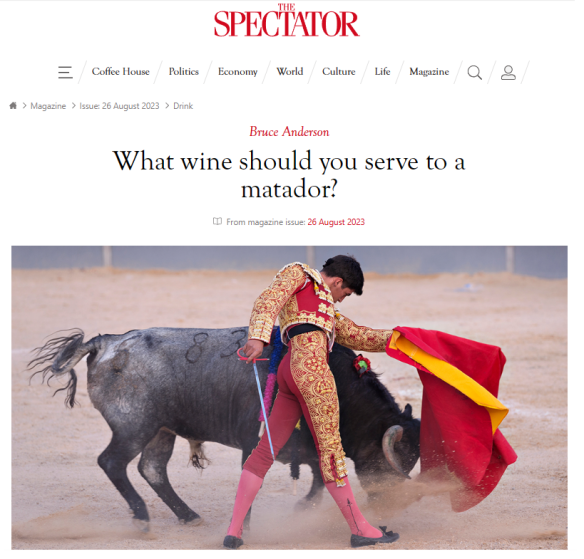An amusing article about me in the oldest – and most successful in current affairs – magazine in the English language, The Spectator, founded in 1828.
Bruce Anderson godfather-patron of the Conservative Party, friend of Prime Ministers (and part of the No.10 Downing Street Policy Unit under Margaret Thatcher) and former political editor of ‘The Speccie’. He interviewed me at The Travellers’ Club, the oldest gentleman’s club on Pall Mall in St. James’, London. Our club is the haunt of diplomats and spies, explorers and mercenaries. I once stayed there and dined with the Papal Nuncio, the Archbishop appointed as Ambassador from the Vatican to the UK, and breakfasted the next day with the Colonel of the Special Boat Service (the SBS is what they modelled the Navy Seals on, for my American readers.) AFH

Original article online here
THE SPECTATOR
Bruce Anderson
What wine should you serve to a matador?
26 August 2023
We were talking bulls. A friend of mine, Alexander Fiske-Harrison, is a remarkable character who can claim at least two distinctions. First, he must have been about the worst-behaved boy in the modern history of Eton College. He claims that this is an understatement and that he heads the role of infamy since the days of Henry VI.
He was certainly put ‘on the Bill’ – that is, for a disciplinary interview with the headmaster – on 68 occasions. So he was fortunate that corporal punishment had been abolished before he arrived, though his career of rapscallionry was possibly not the strongest argument for its demise.
 He must have come close to expulsion. But there was apparently a feeling that Fiske-Harrison would make his mark in the world. And those who argued in that vein might now feel vindicated, because Alexander became a matador.
He must have come close to expulsion. But there was apparently a feeling that Fiske-Harrison would make his mark in the world. And those who argued in that vein might now feel vindicated, because Alexander became a matador.
He insists that this is a slight overstatement and that he is only partially qualified, not the full Escamillo. But he did kill a bull in a ring: impressive enough for me. He is also the first Etonian ever to hold that honour. If not the full Hemingway, he has written well on bullfighting. He also runs with the bulls at Pamplona and other towns: whence a remarkable story which I have mentioned here before.
There is a considerable oenophile called Robin Kelley O’Connor, who runs Christie’s wine activities in New York. He is also an aficionado of bullfighting. Years ago, he was running with the bulls at Sangüesa, near Pamplona. He tripped, fell and was impaled, with a bull’s horn sticking into one bit of his stomach and out the other side. The ambulance broke every speed record on the way to hospital, where doctors saved Robin’s life. Meanwhile, the plane which he should have been on took off. It crashed and there were no survivors.
Twenty years later, Robin started to suffer from gut rot. His doctor concluded that it was caused by scar tissue from the wound, so the medics opened him up to clear it out. While doing so, they spotted a form of bladder cancer, still at an early stage and thus curable. Normally, it would have manifested itself at a much later phase: too late. Robin enquired whether the injury might have provoked the cancer. No reason to think so, he was told. So a fighting bull saved his life twice. That is Androcles and the Lion territory.
Bullfighting is a controversial sport. To enjoy it, one must discard Anglo-Saxon attitudes. You will hear Englishmen insist that it is unfair. In one sense they are right, but they are also being absurd. It would be impossible to have a fair contest between a man and a fighting bull.
As well as being un-English, bullfighting is un-Christian, or certainly pre-Christian. It appeals to the harsher elements of the Spanish character, and the Spanish approach to religion. This is the Spain that used the auto-da-fé to impose faith. These are the Spaniards who fought their way south through an arid and unyielding landscape to reconquer their country and then create a new Spain in Latin America.
To me, the bullfight has a savage majesty, a grace won through extremity and combat. Alexander and I discussed this over a bottle of Viña Tondonia Gran Reserva ’01, a magnificent red, barely at its peak. This is the wine that they ought to be drinking in the matadors’ Valhalla.
Some Spanish lefties regard the bullring as a symbol of a Spain that ought to be consigned to the past. They should learn from that Tondonia: a great wine, drawing on tradition and terroir as well as on modern techniques. To build Spain’s future, the matador and the moderniser can march in step.
